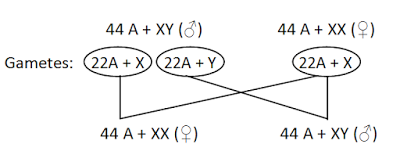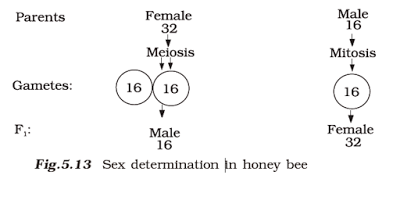Biology
- The Y Chromosome Has Several Male-specific Genes
KEY CONCEPTS:The Y chromosome has ~60 genes that are expressed specifically in testis. The male-specific genes are present in multiple copies in repeated chromosomal segments. Gene conversion between multiple copies allows the active genes to be maintained...
- Notes On Reproduction
Some key points about mitosis and meiosis.Mitosis· Mitosis is where diploid cells produce more diploid cells. This is how all the cells are reproduced, except, the gametes ( sex cells) · ...
- Meiosis
This produces sex cells i.e. sperm and eggs. The sex cells (gametes) have half the number (haploid) of chromosomes, so that when fertilisation occurs the fertised egg has the full compliment of chromosomes (diploid). Look at the following sequence, which...
- Klinefelter's Syndrome Is Caused Due To The
A) absence of one of the X-chromosomes B) presence of additional copy of X-chromosome in males C) trisomy of chromosome number 21 D) presence of additional copy of X-chromosome in females The correct answer is: B) presence of additional copy of X-chromosome...
- Diploid Chromosome Number
Humans have a diploid chromosome number of 46 chromosomes. In other words, there are a total of 46 chromosomes in human cells. The diploid number varies depending on each species. Having a diploid chromosome number means that an organism?s cells contain...
Biology
Sex determination in Animals
Sex chromosomes and Autosomes
Most of the diploid organisms are with separate sexes. The organisms producing sperms are called males and those producing eggs (ova) are called females.
Chromosome is the major factor to determine the sex of an organism.
The chromosomes that are involved in sex determination are called sex chromosomes (allosomes). They include X & Y chromosomes. Autosomes are chromosomes other than sex chromosomes. Number of autosomes is same in males and females.
Henking (1891) studied spermatogenesis in some insects and observed that 50 % of sperm received a nuclear structure after spermatogenesis, whereas other 50 % sperm did not receive it. Henking called this structure as the X body. Later it is called as X-chromosome.
A pair of X-chromosomes (XX) is present in the female, whereas X and Y chromosomes are present in male.
During spermatogenesis, males produce 2 types of gametes- 50 % with X-chromosome and 50 % with Y-chromosome.
Females produce only ovum with an X-chromosome.
There is an equal probability of fertilization of the ovum with the sperm carrying either X or Y chromosome.

Fertilised egg (egg + sperm) develops as a female (queen or worker).
An unfertilised egg develops as a male (drone). It is called parthenogenesis.
Therefore, the females are diploid (32 chromosomes) and males are haploid (16 chromosomes). This is called as haplodiploid sex determination system.

Henking (1891) studied spermatogenesis in some insects and observed that 50 % of sperm received a nuclear structure after spermatogenesis, whereas other 50 % sperm did not receive it. Henking called this structure as the X body. Later it is called as X-chromosome.
Mechanism of sex determination
- XX-XO mechanism: Here, male is heterogametic (XO), i.e. male produces two types of gametes- one with X chromosome and other without X chromosome. Female is homogametic (XX), i.e. female produces only one type of gametes. All gametes are with X-chromosomes. E.g. Many insects such as grasshopper, Cockroach etc.
- XX-XY mechanism: Here, male is heterogametic (X & Y), i.e. male produces two types of gametes- one with X chromosome and other with Y chromosome. Female is homogametic (XX), i.e. female produces only one type of gametes. All gametes are with X-chromosomes. Y chromosome is responsible for the production of male child. E.g. Human & Drosophila.
- ZZ-ZW mechanism: Here, Male is homogametic (ZZ) and female is heterogametic (Z & W). E.g. Birds, reptiles, butterflies etc.
Sex Determination in Humans (XX-XY type)
Human has 23 pairs of chromosomes- 22 pairs of autosomes and 1 pair of sex chromosomes.A pair of X-chromosomes (XX) is present in the female, whereas X and Y chromosomes are present in male.
During spermatogenesis, males produce 2 types of gametes- 50 % with X-chromosome and 50 % with Y-chromosome.
Females produce only ovum with an X-chromosome.
There is an equal probability of fertilization of the ovum with the sperm carrying either X or Y chromosome.

The sperm determines whether the offspring male or female. In our society, females are often blamed for producing female child. In fact, father (male) is responsible for producing female or male child.
Sex determination in honeybee
It is based on the number of sets of chromosomes an individual receives.Fertilised egg (egg + sperm) develops as a female (queen or worker).
An unfertilised egg develops as a male (drone). It is called parthenogenesis.
Therefore, the females are diploid (32 chromosomes) and males are haploid (16 chromosomes). This is called as haplodiploid sex determination system.

In this system, the males produce sperms by mitosis. They do not have father and thus cannot have sons, but have a grandfather and can have grandsons.
- The Y Chromosome Has Several Male-specific Genes
KEY CONCEPTS:The Y chromosome has ~60 genes that are expressed specifically in testis. The male-specific genes are present in multiple copies in repeated chromosomal segments. Gene conversion between multiple copies allows the active genes to be maintained...
- Notes On Reproduction
Some key points about mitosis and meiosis.Mitosis· Mitosis is where diploid cells produce more diploid cells. This is how all the cells are reproduced, except, the gametes ( sex cells) · ...
- Meiosis
This produces sex cells i.e. sperm and eggs. The sex cells (gametes) have half the number (haploid) of chromosomes, so that when fertilisation occurs the fertised egg has the full compliment of chromosomes (diploid). Look at the following sequence, which...
- Klinefelter's Syndrome Is Caused Due To The
A) absence of one of the X-chromosomes B) presence of additional copy of X-chromosome in males C) trisomy of chromosome number 21 D) presence of additional copy of X-chromosome in females The correct answer is: B) presence of additional copy of X-chromosome...
- Diploid Chromosome Number
Humans have a diploid chromosome number of 46 chromosomes. In other words, there are a total of 46 chromosomes in human cells. The diploid number varies depending on each species. Having a diploid chromosome number means that an organism?s cells contain...
